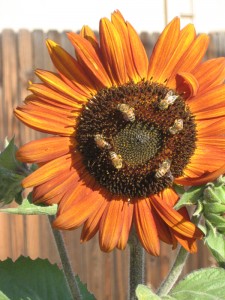
Africanized honeybees
photo by CJ Shane
Bees are the news these days. Either we are told that our food supply is threatened because honeybee pollinators are dying off. Or we hear about “Africanized” honeybees that are attacking and stinging people, sometimes to death. So are the bees our friends or our enemies? They are our friends, but they can be enemies, too, if we don’t pay attention to them and learn how to coexist with them.
There are several kinds of bees in southern Arizona. Each one has its crucial ecological role in pollinating both native desert plants and our garden fruits and vegetables. Africanized honeybees are among the important pollinators so we want them in our gardens. But Africanized bees can become quite aggressive if they think their home colony is under attack. Africanized bees are responsible for several attacks on people in southern Arizona in recent weeks that have led to hospitalizations and one death.
“Africanized” means that our more passive native honeybees have mixed genes with African bees which were introduced into Brazil a half a century ago. By 1990, African bees had made their way north to the U.S. Now almost all feral (wild) honeybees in the American Southwest are Africanized and they are not going away.
“We have to learn to live with Africanized bees, mainly by being educated and alert to them and responding sensibly when encountering or attacked by one or more bees,” says Dr. Justin O. Schmidt of the Southwest Biological Center and University of Arizona’s Entomology Department.
Our food plants, in particular, need the honeybees to produce fruits and vegetables. But nationwide honeybees are in decline. Beekeepers began noticing in 2006 that honeybee populations were disappearing from their colonies. This phenomenon was named “colony collapse disorder.” The disorder is considered a real threat to U.S. agriculture. Since 2006, one-third of all American honeybees have disappeared. A recent federal research report found that there are many causes for the disorder but residual pesticides are a prime suspect. Because honeybees pollinate everything from apples to zucchini, their disappearance is having a negative impact on American agriculture. Already the U.S. imports up to 35% of our fruits and vegetables. Some experts fear that we will be forced to import all of our fruits and veggies if honeybees continue to die off.
What can Tucsonans do to help our pollinating honeybees? Emily Rockey, Curator of Horticulture at Tucson Botanical Gardens, recommends planting those native legumes (bean producing) trees we know so well – mesquite, palo verde, ironwood, etc. Also popular with the bees are flowering plants in the Asteraceae family. Examples are asters, daisies, and sunflowers.
“Bees like mint and rosemary, too, and they are attracted especially to blue, white, and yellow flowers,” adds Rockey.
Keep in mind that when collecting pollen, honeybees are away from their colonies and are not typically aggressive. The honeybees in the photo above are very likely Africanized. They were far more interested in the sunflower pollen than in the photographer taking their picture.
Rockey says that Tucson Botanical Gardens are “quite a bee hub” for several species of bees, including those Africanized honey bees. “I can’t remember the last time anyone was even stung here,” says Rockey. “We’ve had maybe five swarms come through, and a couple attempted to stay permanently.” She says those swarms were relocated from the gardens.
Yet multiple bee attacks occur every year in southern Arizona. What can you do to avoid being attacked by angry bees?
Africanized bees only attack when they think their home colony is threatened, says Dr. Schmidt. When worker bees are away from the colony and collecting pollen, they are non-aggressive, he adds. Even swarms of Africanized bees in transition to a new colony site are not very aggressive. But it’s a different story if they think you are disturbing their home colony.
Avoid triggering the bees which might think you are threatening their colony or their “baby bedroom” as Dr. Schmidt calls the colony. Avoid wearing artificial fragrances or dark clothes and using shiny objects when around bees. Don’t make loud noises either because that just gets their attention. Never poke a hive with a stick. Dr. Schmidt recommends, too, that you unplug your music when out hiking so you can listen for loud buzzing sounds. If you hear or see large numbers of bees, then quickly head the other way!
Greg Denker of American Bee Control in Tucson takes a proactive approach. “Paying attention is good, but I think not really enough,” Denker says. “To be safe from bees, one needs to be on the lookout for bees that have established a colony.Bees become dangerous to mammals only when the bee colony is either very large or when there are a lot of babies on board. Bees are very protective of their young, like a mother bear protecting her cub.Identifying hive locations (for example when a feral colony has taken up residence in an attic or shed) can help homeowners take proactive measures to have the bees removed before they become a threat or other unnecessary nuisance.”
Denker explains that a hive or colony “can almost always be identified by the aerial stream of bees” that are entering or exiting a location. He says the flight activity is “most easily seen in the late afternoon when the sun is low in the sky thus easier for humans to see the reflected glint of the flapping wings.”
“In my experience,” adds Denker, “when bees ‘attack’ a porch light, or other outside light at night, it typically means there is an active colony within 200 feet, and the entrance to the hive has line-of-sight view of the light bulb. That’s when you need to call in the pros to remove the hive.”
What do you do when you find yourself the object of negative attention from some angry bees?
Don’t freeze in place and start swatting. Run! Run away from the bees, preferably into the wind, because a healthy adult can outrun a swarm of bees. Try to protect your head and face, even if it means pulling your shirt up around your face. Seek shelter indoors in a building or a car as quickly as possible. Don’t jump into water. The bees will just hover above the water’s surface waiting for you to come up for air. Once inside shelter, call for emergency help. Seek medical assistance if you have been stung repeatedly.
By learning more about the bees and taking action before there is a problem, we can learn to coexist successfully with our Africanized honeybees.







Also find us on...